
The Guild S300 was launched in 1977, effectively a replacement to the SG-style S-100 solid body guitars. Guild had not tried any particularly original solid body designs for several years, so the S-300, (along with its companion S-60 and S-70 guitars, and B-301 and B-302 basses) was a welcome change for the guitar buying public. Functionally the guitars were well-equipped, with dual humbucking pickups, three-way (neck/bridge/both) pickup selector switch, volume and tone control for each pickup, and a phase switch for "reversing pickup polarity".
The 1978 Guild guitar catalogue (right) featured a pair of white S-300 guitars on its front cover.
The Guild S-300 was available in a number of different forms. Different wood and pickup combinations, for a much wider range of tones.
Guild S-300 mahogany body and neck, two Guild humbucker pickups
Guild S-300D mahogany body and neck, DiMarzio PAF and Super Distortion humbuckers
Guild S-300A ash body and maple neck, two Guild humbucker pickups
Guild S-300AD ash body and maple neck, DiMarzio PAF and Super Distortion humbuckers
All models have a 24 fret curved ebony fingerboard, with dot markers (24¾ inch scale), and traditional Guild Chesterfield headstock inlay.
The ash models were available in blonde (natural) and sunburst finishes. The mahogany models were also available in natural (though obviously much darker than ash) aswell as sunburst, cherry, black, walnut and white.
The S-300 remained in production until 1989, when it was discontinued. The Ash and Dimarzio pickup options were stopped earler still in 1982.
Electric guitar advertisements originally published from 1977 onwards. Click on the images for larger copies. Check out other vintage Guild advertisements
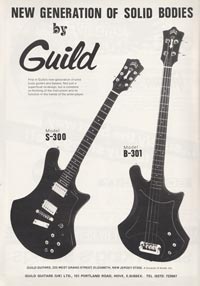
Guild S-300 - New Generation of Solid Bodies By Guild (1977)
United Kingdom Guild advertisement for two new solid body models, the S-300 guitar and single pickup B-301 bass.
[more]
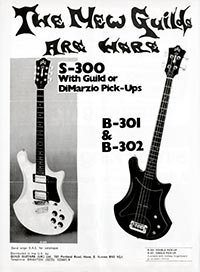
Guild S-300 - The New Guilds Are Here (1977)
Late 1977 UK advertisement for the new Guild S-300 guitar and B-301 / B-302 basses. The S-300 (in white) is advertised as available with Guild (as shown) or DiMarzio pickups. The bass pictured is t...
[more]
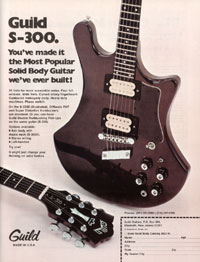
Guild S-300 - Youve made it the most popular solid body guitar weve ever built (1978)
The Guild S-300 came in a number of variations, the model pictured is an S-300D, signifying the standard mahogany body and neck with (D) DiMarzio PAF and Super Distortion humbuckers. Non-D versions...
[more]
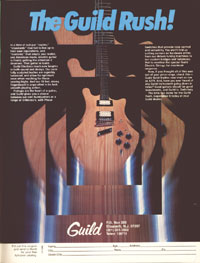
Guild S-300 - The Guild Rush (1980)
The Guild S-300 came in a number of variations, the model pictured is an S300-AD, signifying (A) ash body and maple neck, and (D) DiMarzio PAF and Super Distortion humbuckers.
[more]
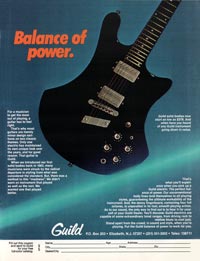
Guild S-300 - Balance of Power (1981)
1981 Guitar Player advertisement for Guild solid body guitars, featuring the S-300, available since 1977. The S-300 was available with different body and neck woods and a choice of Guild or Dimarzi...
[more]
$5500
$55
$1649
$2295
$35
£721